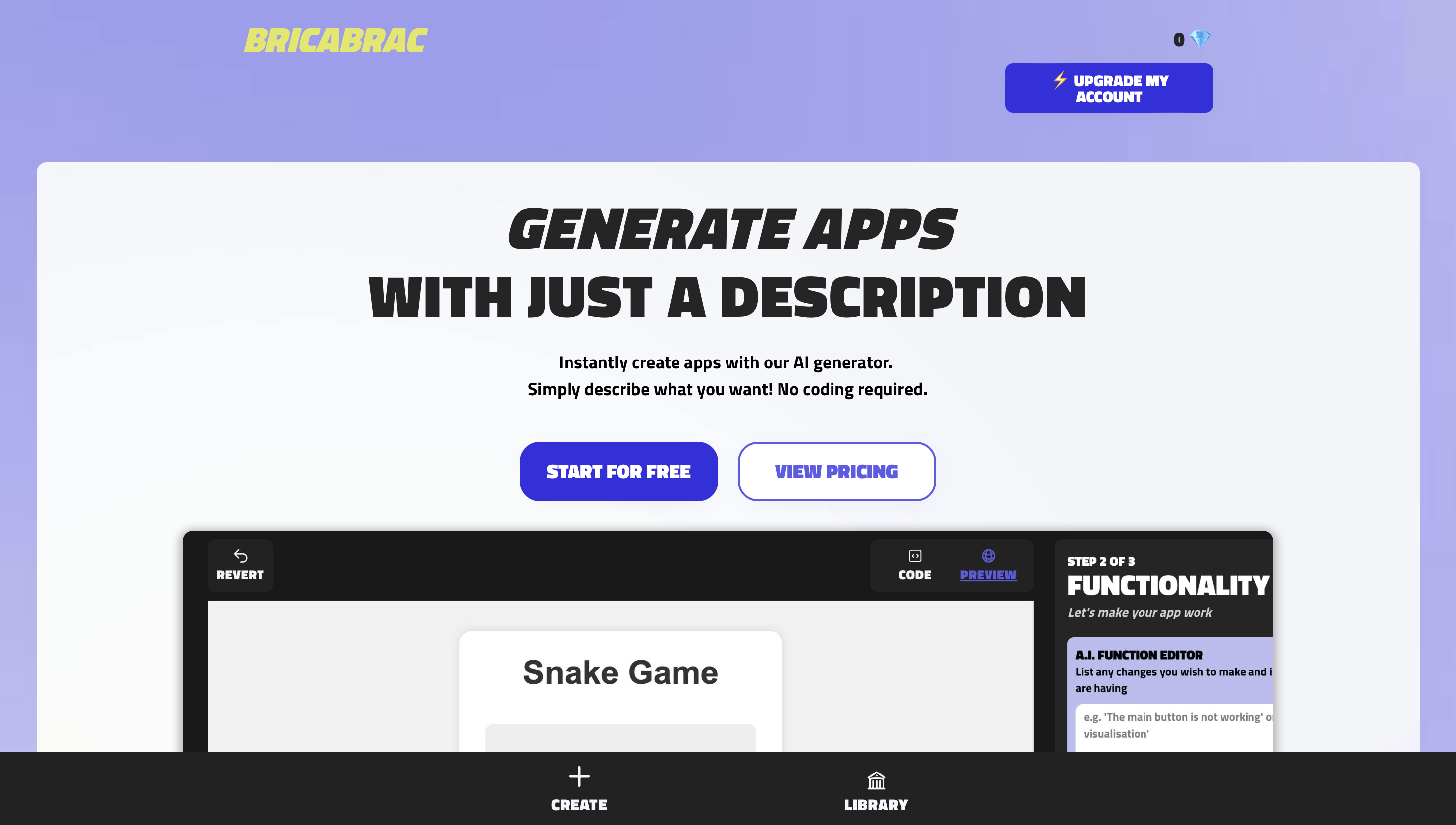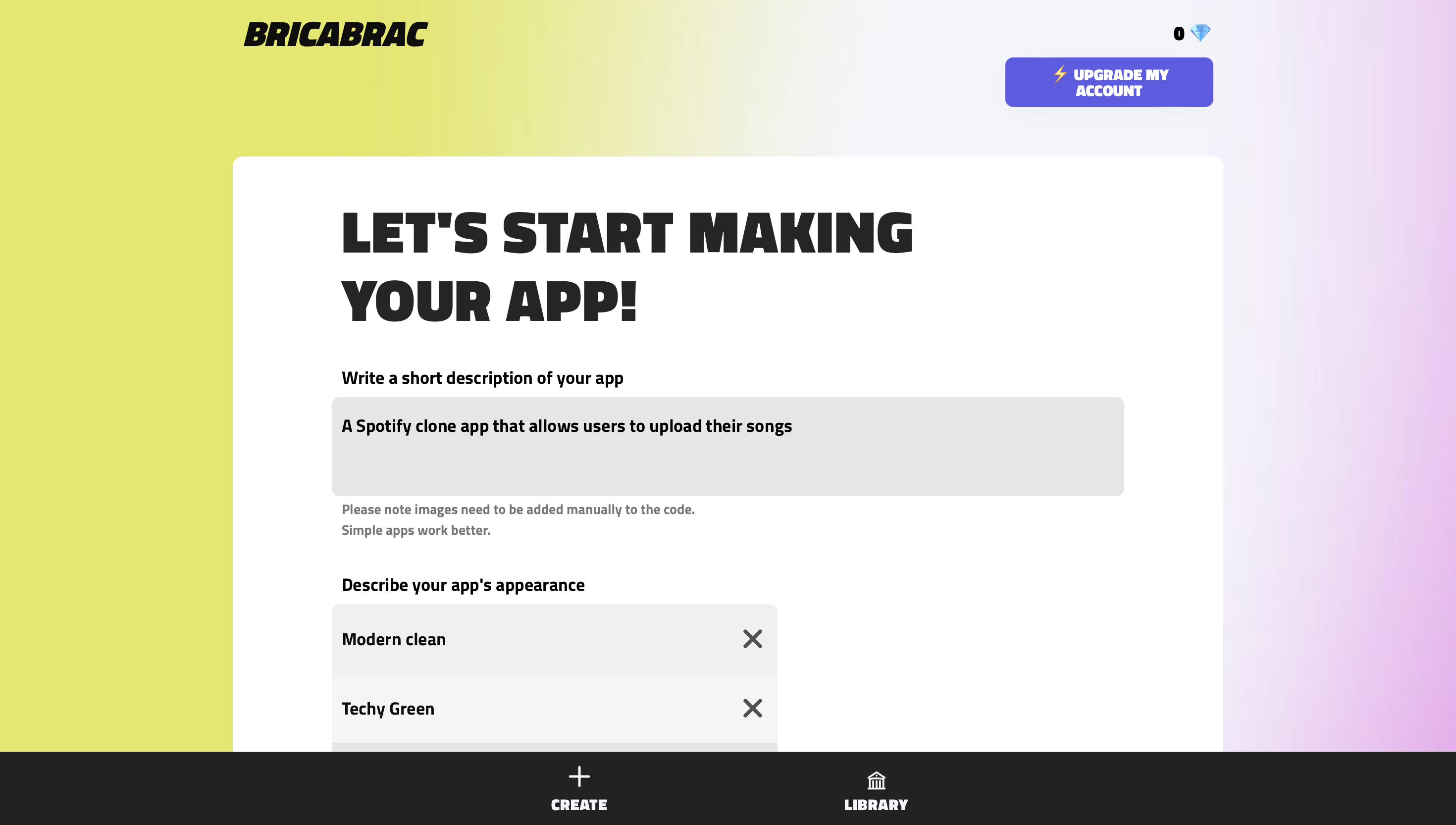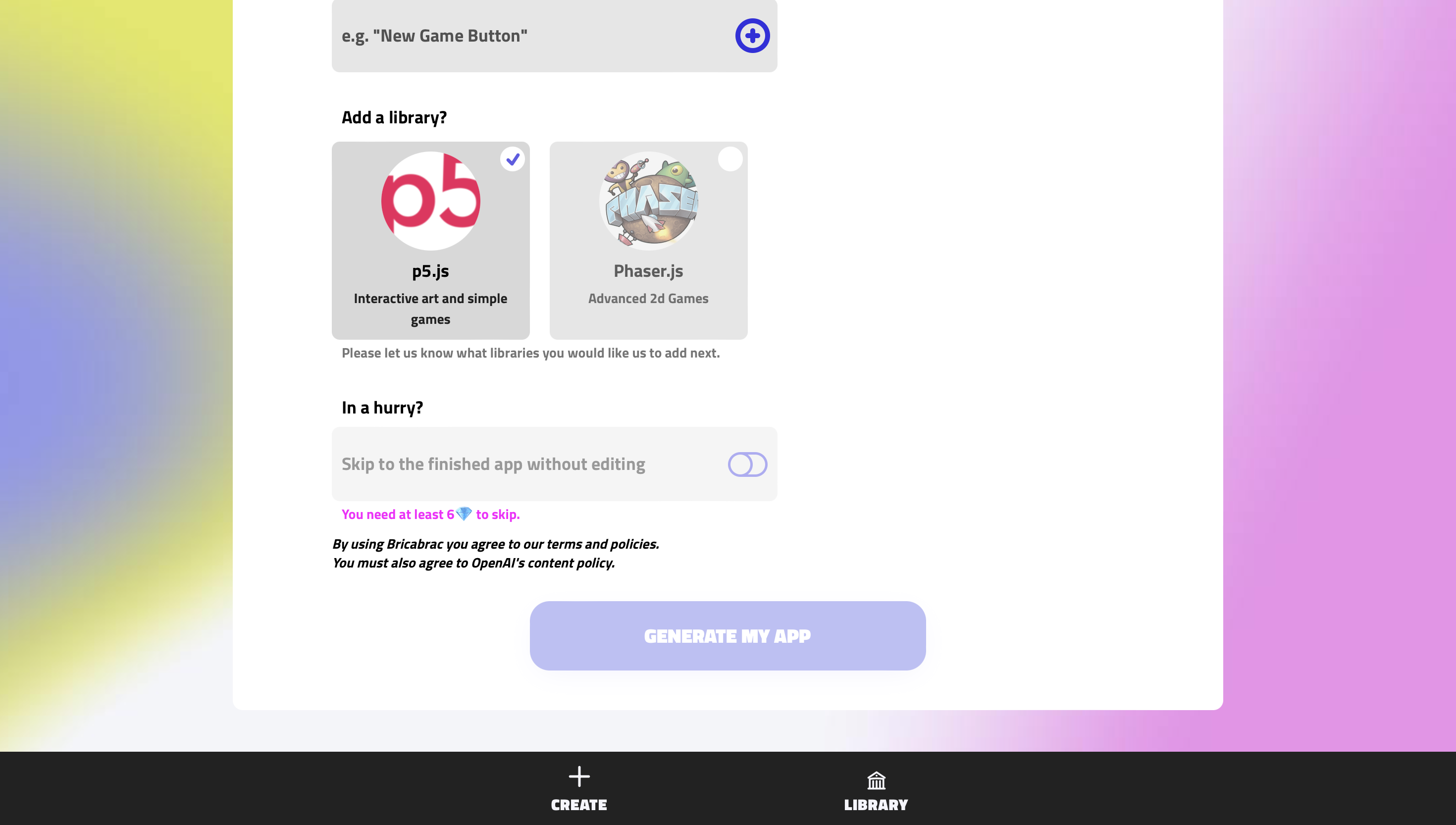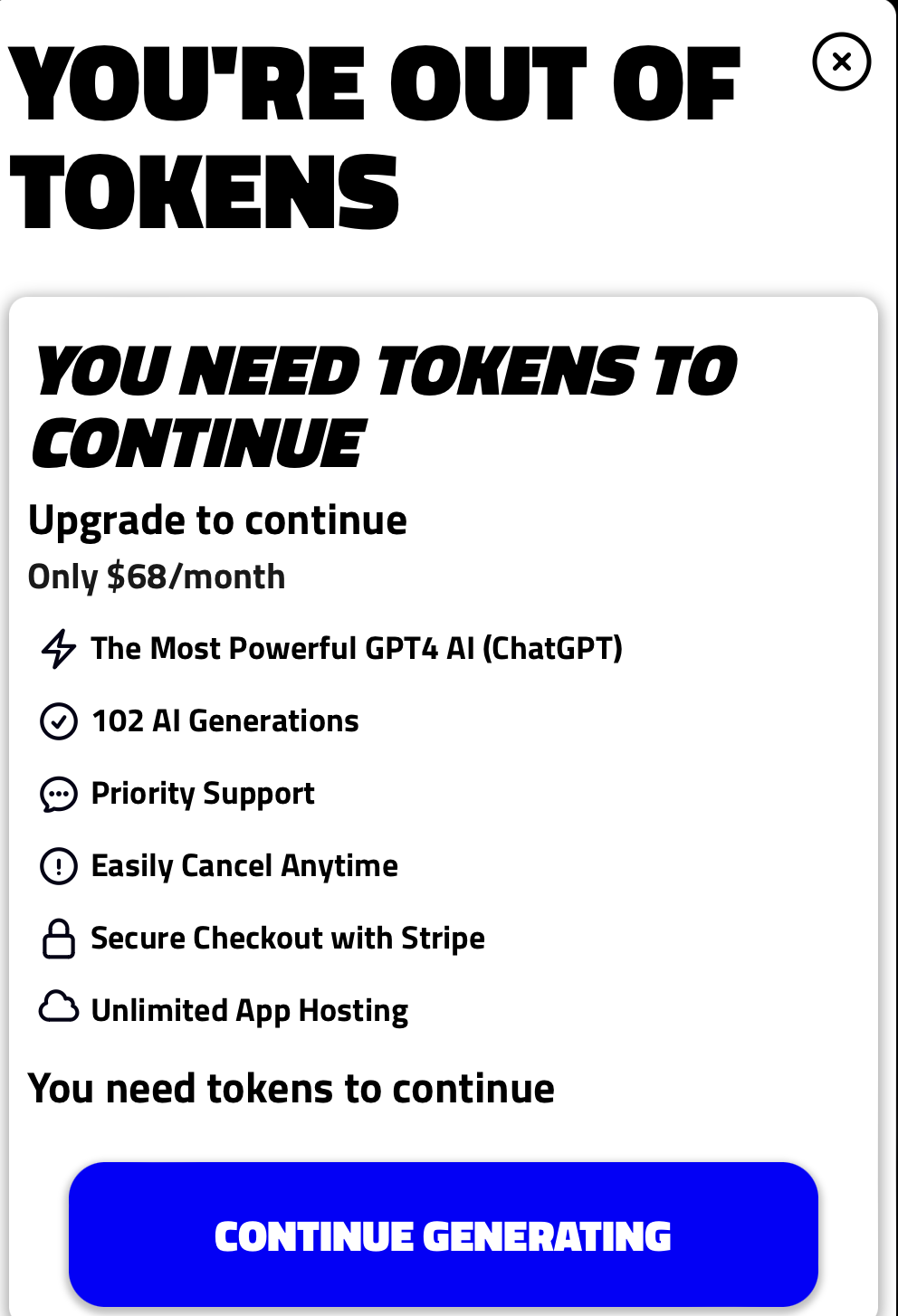Bricabrac: AI App Creation or Just Fancy Code Weaving?
Bricabrac: AI App Creation or Just Fancy Code Weaving?
So, you've got this amazing app idea, right? The next Uber, the next TikTok, the next... something that'll make you millions and let you retire to a beach where the Wi-Fi still works. There's just one tiny problem: you and code are about as compatible as cats and baths.
Enter the world of "no-code" tools, promising app creation so easy your grandma could do it. And among these shiny new toys is Bricabrac, waving its AI-powered wand and claiming to conjure apps from mere words. Sounds magical, doesn't it?
But as someone who's peeked behind the curtain (spoiler: it's mostly good old HTML, CSS, and JavaScript), I had to ask: Is Bricabrac really a game-changer, or just a cleverly disguised code generator with a premium price tag? Let's break out the magnifying glass and see if this AI wizardry is worth the hype.

Under the Hood: Bricabrac's Spellbook (How It Actually Works)
Forget bubbling cauldrons and ancient grimoires - Bricabrac's magic is powered by something a bit more modern: the GPT-4 or GPT-4 Turbo API. Yup, that's right, the same AI engine that can write poems, translate languages, and even pen a decent screenplay is the secret sauce behind this app-building wizardry.
Here's how the enchantment unfolds:
- You Whisper the Spell: You feed Bricabrac a plain-English description of your dream app. What's it for? What should it look like? What magical features should it possess? Be as detailed or as vague as you like - GPT is surprisingly good at filling in the gaps.
- Bricabrac Consults the Oracle: Your text prompt is whisked away to the GPT-4 oracle (aka, a supercomputer somewhere). The AI engine analyzes your words, deciphers your intentions, and consults its vast knowledge of code and design principles.
- Code Appears From Thin Air: Like a rabbit from a hat, GPT-4 spits out a functional web app - HTML skeleton, CSS styling, and all the JavaScript incantations to make it work. It might not be perfect yet, but it's a working framework.
Now, while this sounds like pure sorcery, remember that GPT is essentially a master code weaver. It's learned from millions of lines of code, so it knows how to structure a basic app, stitch together elements, and even sprinkle in some visual flair. But is this weaving intricate tapestries or just patching together pre-made code snippets? That's the question we'll explore further...
My Magical Experiments: Trying Out Bricabrac's Tricks
Okay, let's get our hands dirty and see what Bricabrac can actually do. I decided to test its mettle with a classic "no-code" challenge: building a simplified Spotify clone. Think basic music upload, playback, and a clean interface - just enough to get a feel for the AI's capabilities.
The spellcasting process itself was surprisingly smooth. Bricabrac's interface is easy to use, and it guided me through a series of text prompts:

- App Description: "A Spotify clone app that allows users to upload their songs" (straightforward, right?)
- App Appearance: "Modern clean, Techy Green, Subtle Drop Shadows" (gotta have that sleek vibe).
- Features: "Upload song button, Using the Web Midi API" (aiming high, I know).

And with a flick of the "Generate App" button, Bricabrac retreated to its digital lair to weave its code magic. After a few minutes, poof - a basic web app appeared.
First Impressions: A Beautiful But Lifeless Skeleton The generated code (which you can peruse above) looked the part. It was indeed a well-structured HTML skeleton with CSS styling that captured the "Techy Green" aesthetic. It even included placeholder elements for song listings, playback buttons, and the upload feature.
The Big Illusion: Functionality is a Mirage: Here's where the magic trick falters. This skeleton, while visually appealing, was largely non-functional. The "Upload Song" button? It opened a file dialogue, but nothing actually happened with the selected file. Playback? Nonexistent. The Web Midi API, which I'd hoped would add some interactivity, was completely absent.

Bricabrac's Sweet Spot: Simpler Spells: Reviewing the code, it's clear that Bricabrac is more adept at crafting the lookof an app than its complex inner workings. The HTML and CSS are well-written, but the JavaScript is where things get rudimentary. This leads me to believe Bricabrac would excel at creating simpler apps - a classic Snake game, a basic calculator, a static portfolio website. But anything requiring robust backend logic or intricate user interactions seems beyond its current capabilities.
<!DOCTYPE html>
<html lang="en">
<head>
<meta charset="UTF-8">
<meta name="viewport" content="width=device-width, initial-scale=1.0">
<title>Spotify Clone</title>
<style>
:root {
--primary-color: #1DB954;
--secondary-color: #191414;
--text-color: #FFFFFF;
--background-color: #121212;
}
* {
margin: 0;
padding: 0;
box-sizing: border-box;
}
body {
font-family: -apple-system, BlinkMacSystemFont, 'Segoe UI', Roboto, Oxygen, Ubuntu, Cantarell, 'Open Sans', 'Helvetica Neue', sans-serif;
background-color: var(--background-color);
color: var(--text-color);
}
.container {
max-width: 1200px;
margin: 0 auto;
padding: 20px;
}
header {
display: flex;
justify-content: space-between;
align-items: center;
padding: 20px 0;
}
.logo {
font-size: 24px;
font-weight: bold;
color: var(--primary-color);
}
nav ul {
display: flex;
list-style-type: none;
}
nav ul li {
margin-left: 20px;
}
nav ul li a {
color: var(--text-color);
text-decoration: none;
font-size: 16px;
}
main {
display: flex;
flex-direction: column;
align-items: center;
padding: 40px 0;
}
h1 {
font-size: 36px;
margin-bottom: 20px;
}
.upload-button {
background-color: var(--primary-color);
color: var(--text-color);
border: none;
padding: 12px 24px;
font-size: 18px;
border-radius: 30px;
cursor: pointer;
transition: background-color 0.3s ease;
}
.upload-button:hover {
background-color: #1ED760;
}
.song-list {
width: 100%;
margin-top: 40px;
}
.song-item {
background-color: var(--secondary-color);
border-radius: 8px;
padding: 20px;
margin-bottom: 20px;
display: flex;
justify-content: space-between;
align-items: center;
}
.song-info {
display: flex;
align-items: center;
}
.song-title {
font-size: 18px;
font-weight: bold;
margin-right: 10px;
}
.song-artist {
font-size: 14px;
color: #B3B3B3;
}
.song-controls button {
background-color: transparent;
border: none;
color: var(--text-color);
font-size: 16px;
cursor: pointer;
margin-left: 10px;
}
@media (max-width: 768px) {
header {
flex-direction: column;
align-items: flex-start;
}
nav ul {
margin-top: 20px;
}
nav ul li {
margin-left: 0;
margin-right: 20px;
}
}
</style>
</head>
<body>
<div class="container">
<header>
<div class="logo">Spotify Clone</div>
<nav>
<ul>
<li><a href="#" id="homeLink">Home</a></li>
<li><a href="#" id="libraryLink">Library</a></li>
<li><a href="#" id="profileLink">Profile</a></li>
</ul>
</nav>
</header>
<main>
<h1>Upload Your Songs</h1>
<button class="upload-button">Upload Song</button>
<div class="song-list"></div>
</main>
</div>
<script>
let songs = [
{ id: '1', title: 'Sample Song 1', artist: 'Artist 1', file: null },
{ id: '2', title: 'Sample Song 2', artist: 'Artist 2', file: null },
{ id: '3', title: 'Sample Song 3', artist: 'Artist 3', file: null }
];
let currentAudio = null;
function generateUniqueId() {
return Date.now().toString(36) + Math.random().toString(36).substr(2);
}
function addSongToList(song) {
const songList = document.querySelector('.song-list');
const songItem = document.createElement('div');
songItem.className = 'song-item';
songItem.innerHTML = `
<div class="song-info">
<span class="song-title">${song.title}</span>
<span class="song-artist">${song.artist}</span>
</div>
<div class="song-controls">
<button class="play-btn" data-id="${song.id}">Play</button>
<button class="delete-btn" data-id="${song.id}">Delete</button>
</div>
`;
songList.appendChild(songItem);
}
function saveSongsToLocalStorage() {
localStorage.setItem('songs', JSON.stringify(songs));
}
function loadSongsFromLocalStorage() {
const storedSongs = localStorage.getItem('songs');
if (storedSongs) {
songs = JSON.parse(storedSongs);
}
songs.forEach(song => addSongToList(song));
}
function handleFileUpload(event) {
const file = event.target.files[0];
if (file && file.type.startsWith('audio/')) {
const reader = new FileReader();
reader.onload = function(e) {
const song = {
id: generateUniqueId(),
title: file.name.split('.').slice(0, -1).join('.'),
artist: 'Unknown Artist',
file: e.target.result
};
songs.push(song);
addSongToList(song);
saveSongsToLocalStorage();
};
reader.readAsDataURL(file);
} else {
alert('Please upload a valid audio file.');
}
}
function playSong(id) {
const song = songs.find(s => s.id === id);
if (song) {
if (currentAudio) {
currentAudio.pause();
}
if (song.file) {
currentAudio = new Audio(song.file);
currentAudio.play();
} else {
alert('This is a sample song without an audio file.');
}
}
}
function deleteSong(id) {
songs = songs.filter(s => s.id !== id);
saveSongsToLocalStorage();
const songItem = document.querySelector(`.song-item .delete-btn[data-id="${id}"]`).closest('.song-item');
songItem.remove();
}
document.querySelector('.upload-button').addEventListener('click', function(e) {
e.preventDefault();
const fileInput = document.createElement('input');
fileInput.type = 'file';
fileInput.accept = 'audio/*';
fileInput.style.display = 'none';
document.body.appendChild(fileInput);
fileInput.click();
fileInput.addEventListener('change', handleFileUpload);
document.body.removeChild(fileInput);
});
document.querySelector('.song-list').addEventListener('click', function(e) {
e.preventDefault();
if (e.target.classList.contains('play-btn')) {
playSong(e.target.dataset.id);
} else if (e.target.classList.contains('delete-btn')) {
deleteSong(e.target.dataset.id);
}
});
document.addEventListener('DOMContentLoaded', loadSongsFromLocalStorage);
const dropZone = document.querySelector('.container');
dropZone.addEventListener('dragover', function(e) {
e.preventDefault();
e.stopPropagation();
this.style.background = 'rgba(29, 185, 84, 0.1)';
});
dropZone.addEventListener('dragleave', function(e) {
e.preventDefault();
e.stopPropagation();
this.style.background = '';
});
dropZone.addEventListener('drop', function(e) {
e.preventDefault();
e.stopPropagation();
this.style.background = '';
const files = e.dataTransfer.files;
if (files.length > 0 && files[0].type.startsWith('audio/')) {
handleFileUpload({ target: { files: [files[0]] } });
} else {
alert('Please drop a valid audio file.');
}
});
document.addEventListener('keydown', function(e) {
if (e.code === 'Space') {
e.preventDefault();
if (currentAudio) {
if (currentAudio.paused) {
currentAudio.play();
} else {
currentAudio.pause();
}
} else {
const firstPlayBtn = document.querySelector('.play-btn');
if (firstPlayBtn) {
firstPlayBtn.click();
}
}
}
});
function adjustLayoutForMobile() {
const container = document.querySelector('.container');
if (window.innerWidth <= 768) {
container.style.padding = '10px';
} else {
container.style.padding = '20px';
}
}
window.addEventListener('resize', adjustLayoutForMobile);
adjustLayoutForMobile();
document.getElementById('homeLink').addEventListener('click', function(e) {
e.preventDefault();
alert('Home page functionality not implemented');
});
document.getElementById('libraryLink').addEventListener('click', function(e) {
e.preventDefault();
alert('Library page functionality not implemented');
});
document.getElementById('profileLink').addEventListener('click', function(e) {
e.preventDefault();
alert('Profile page functionality not implemented');
});
</script>
</body>
</html>
Code Notes:
- Solid Front-End Basics: The HTML structure is logical, and the CSS uses variables effectively for styling consistency.
- Rudimentary JavaScript: The provided JavaScript sets up event listeners for the upload button and song list, but the actual logic for handling uploads, playback, and song storage is incomplete.
- Missing Functionality: Key features like actual song upload handling, playback controls, and Web Midi API integration are missing.
- Placeholders Galore: The code is filled with placeholder elements and comments indicating unimplemented functionality.
Limitations: Bricabrac's Not-So-Magical Moments
Alas, even the most powerful wizards have their limits, and Bricabrac is no exception. While it excels at conjuring visually appealing app skeletons, cracks start to appear when you demand more from its AI spellbook.
The Simplicity Barrier: As my Spotify clone experiment revealed, Bricabrac's sweet spot is in the realm of simple, primarily static apps. Think basic games, landing pages, or tools with limited interactivity. The moment you venture into territory requiring complex logic, backend functionality, or advanced API integrations, Bricabrac starts fumbling for its wand.
The AI Whisperer's Dilemma: While the promise of text-to-app conversion is alluring, communicating your intent perfectly to an AI can be trickier than it sounds. Bricabrac's GPT-powered engine is impressive, but it's still prone to misinterpretations. Subtle nuances in your descriptions might get lost in translation, leading to features that are almostright, but not quite what you envisioned.
Code Tinkering is Inevitable: Bricabrac isn't truly "no-code." It's more like "low-code" - a code generator that provides a solid foundation but still requires manual adjustments for anything beyond the basics. Want to add a unique user authentication system? Implement a payment gateway? Bricabrac can't handle that heavy lifting on its own. You'll need coding knowledge to customize and extend the generated code.
Support Spells...Missing?: And here's where a real concern arises. In an attempt to go deeper into Bricabrac's potential, I reached out to their support email, hi@bricabrac.ai, requesting pro access for more thorough testing. To my surprise, the email bounced back with a "NoSuchUser" error. Google helpfully suggested I "double-check the recipient's email address for typos," but alas, the address was correct.
This raises a red flag. If a seemingly basic support channel is non-functional, it begs the question: how responsive and reliable is Bricabrac's support in general? What happens when you encounter a genuine technical issue or need assistance with the tool?
The Big Question: Are the Limits Acceptable? This depends entirely on your expectations and needs. If you're a non-coder seeking to quickly prototype simple apps or build basic web tools, Bricabrac's limitations might be acceptable. It can save you time and effort on the front-end scaffolding.
However, if you're hoping for a truly "no-code" solution to build complex, fully functional apps, Bricabrac will likely leave you wanting more. Its AI is powerful, but it's not a magic bullet that can eliminate the need for coding altogether. And given its premium price tag coupled with the questionable support situation, one has to wonder if those funds might be better invested in learning some basic coding skills or opting for a more robust no-code platform that offers reliable assistance.
The bottom line? Bricabrac is an intriguing tool with a lot of potential, but its limitations, particularly regarding functionality and the concerning lack of accessible support, are serious factors to consider before you hand over your hard-earned gold to this AI wizard.
Pricing and Plans: How Much for a Magic Wand? (Or Just a Fancy Spellbook Cover?)
Let's talk turkey about Bricabrac's pricing, and how it stacks up against a certain AI heavyweight in the room: ChatGPT.

As we've established, Bricabrac's "Power Plan" will set you back $68 a month for 102 AI app generations. Now, consider ChatGPT Plus, clocking in at a mere $20 a month. With ChatGPT Plus, you get unlimited access to GPT-4, the very same AI engine that powers Bricabrac.
Think about that for a moment. For less than a third of the price, you can directly access the source of the magic, and it's not limited to just app generation. ChatGPT can write code for you, answer your questions, help you brainstorm, translate languages - it's a veritable Swiss Army Knife of AI.
Bricabrac's Glimmering Facade: So what exactly does Bricabrac offer that ChatGPT doesn't? Essentially, it boils down to three things:
- A User-Friendly Interface: Bricabrac's interface is undoubtedly sleek and intuitive. It guides you through the app creation process with clear prompts and a visually appealing design.
- Tailored Prompts: Bricabrac's prompts are specifically designed to extract the necessary information for app generation. This streamlines the process for those who might not be familiar with how to structure coding requests for ChatGPT.
- App Store Export: Bricabrac seemingly offers a way to directly export your generated apps to the App Store, which could potentially save time and hassle.
The Million-Dollar Question: Is It Worth It? Here's the hard truth: while Bricabrac's interface and prompt system are convenient, they might not justify the hefty price difference. For users comfortable with interacting with ChatGPT directly, the cost savings are significant.
ChatGPT, with a little guidance and cleverly crafted prompts, can generate the same HTML, CSS, and JavaScript code that Bricabrac produces. And while you'll need to manually set up your development environment and handle App Store submission, these are tasks that many no-code enthusiasts are willing to learn for the sake of affordability and flexibility.
Bricabrac's Dilemma: To truly compete, Bricabrac needs to offer something more than just a pretty interface and convenient prompts. It needs to demonstrate a level of AI sophistication and functionality that significantly surpasses what users can achieve with ChatGPT alone. Otherwise, it risks being seen as a luxury spellbook cover for an AI engine that's readily available at a fraction of the cost.
Privacy and Terms: No Dark Arts Here? (More Like a Shrouded Mystery...)
When it comes to privacy and terms of service, transparency is paramount, especially when dealing with AI tools that handle your data and code. So, where does Bricabrac stand on this front?
Well, prepare for a plot twist: Bricabrac has no publicly available privacy policy.
You read that right. No privacy policy. Nada. Nichts!
This is, to put it mildly, concerning. In an age where data privacy is a major concern, it's frankly baffling that a tool handling user input and generating code wouldn't have a clear, accessible policy outlining how that information is used, stored, and protected.
The Missing Spellbook of Transparency: Without a privacy policy, we're left with a gaping void of unknowns:
- What data does Bricabrac collect? Your app descriptions, generated code, potentially even usage patterns? It's anyone's guess.
- How is this data used? Is it used to train their AI, shared with third parties, or sold for profit? Again, no way to know.
- Who owns the generated code? Do you retain full rights, or does Bricabrac claim ownership? This has significant implications for your app's future.
The Verdict: Proceed With Extreme Caution Until Bricabrac addresses this glaring lack of transparency, it's impossible to recommend this tool with any degree of confidence. Handing over your app ideas and code to a platform that operates in a privacy black box is simply too risky. No matter how impressive the AI wizardry might be, it's not worth compromising your data security and potentially even your app's ownership rights.
Conclusion: Bricabrac - A Glimmering Illusion or a True Game-Changer?
So, after peeking behind the curtain, dissecting the code, and grappling with the unsettling absence of a privacy policy, is Bricabrac the revolutionary AI app builder it claims to be? The answer, as with most things AI-related, is a nuanced "it depends."
A Neat Trick, But Not Quite Magic: Bricabrac undeniably offers a glimpse into the future of app development. The speed and ease with which it generates basic web apps is impressive, and its user-friendly interface makes the process accessible to even the most code-averse individuals.
Limited Power, Niche Appeal: However, Bricabrac's limitations are significant. Its AI, while capable, is not a magic wand that can conjure complex, fully functional apps from thin air. It's more of a digital artisan, crafting beautiful but often lifeless skeletons that require a skilled coder's touch to truly come to life.
The Ideal Apprentice: This makes Bricabrac best suited for hobbyists seeking to dabble in app creation or entrepreneurs with very simple app needs. If you're looking to build a basic game, a static landing page, or a simple web tool, Bricabrac can save you time and effort on the front-end development.
The Transparency Spell Remains Uncast: However, the lack of a privacy policy casts a long, dark shadow over the tool's potential. Until Bricabrac addresses this critical issue and provides clear, transparent information about how it handles user data and code, it's impossible to recommend this tool without reservations.
AI's App-Building Odyssey: Bricabrac is a fascinating case study in the ongoing evolution of AI in app development. While it's not yet the paradigm-shifting tool some might have hoped for, it highlights the incredible potential of AI to democratize technology and empower individuals to bring their ideas to life. As AI models continue to advance, we can expect to see even more powerful and versatile tools emerge, blurring the line between code and creation, and perhaps, one day, truly making app-building as easy as whispering a spell.





